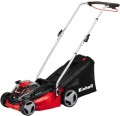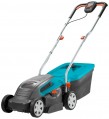Cutting width
The capture width provided by the unit, in other words, the width of the strip of land cultivated in one pass. In fact, this size corresponds to the width of the working nozzle.
The large working width is useful when processing large open spaces, as it allows you to finish the job in a small number of passes. On the other hand, for hard-to-reach places, relatively narrow tools are better suited, able to go where a wider unit will not fit. In addition, the width of the tool directly affects the weight and price.
In general, it makes sense to compare in terms of working width only units of the same type (see above). However, it is worth noting here that trimmers do not differ so much from each other — most models capture from 25 to 45 cm (and a wide processing band is provided by moving the nozzle from side to side). As for the other types, in the most modest models the capture width
does not exceed 40 cm, in the heaviest and most powerful it can be
56 – 60 cm or even
more(in mini tractors — up to 1.5 m).
Min. cutting height
The minimum cutting height provided by the lawnmower — that is, the smallest height of grass that can remain after the passage of the machine. It makes sense to pay attention to this indicator mainly in cases where the lawn is planned to be cut as short as possible. In addition, the lower the minimum height (with the same maximum), the wider the height adjustment range of this model.
Max. cutting height
The maximum cutting height that the lawn mower can achieve is the maximum height of grass that can be left after the machine has passed.
This parameter is relevant mainly for those cases when you want to leave the grass on the lawn relatively long. In addition,
lawn mowers with high cutting heights have a wide range of mowing adjustments.
Number of height settings
The number of cutting height settings provided by the lawn mower. The more such settings (with the same adjustment range) — the more accurately you can choose the mowing height. Note that in some robots (see "Type") this number reaches 30 or more with a range of 30 to 60 mm; in other words, you can select the height to the nearest millimetre.
Features
-
Self-propelled. In self-propelled lawn mowers, the engine rotates not only the cutting tool, but also the wheels of the lawn mower; thus, the user does not need to push it in front of him - it is enough just to set and control the direction of movement. This is convenient, but such models are more expensive than non-self-propelled ones. This is due not only to the complexity of the design, but also to the fact that such devices require more powerful engines - after all, power must be divided between the cutting nozzle and the chassis. For the same reason, a self-propelled unit will be less productive and efficient than a non-self-propelled analogue of the same power. However, some types of lawn mowers are by definition self-propelled - in particular, these are heavy professional models that would be difficult to push with your hands, as well as
mini tractor riders(see "Type").
-
Height adjustable handle. Possibility of height adjustment of the lawn mower handle, which allows to optimally adjust the device to the height of the user. This feature is especially useful for short or, conversely, tall people - by default, lawn mower handles are made for medium height, and it would be inconvenient to work with the unit without height adjustment.
-
Piano wheels. The lawn mower has special, so-called. caster wheels (similar to th
...ose used, for example, in supermarket carts). These wheels automatically turn in the direction of movement of the device, which significantly reduces the turning radius of the lawn mower and increases its maneuverability. At the same time, it is worth noting that this design is usually used only for the front wheels, while the rear ones remain rigidly fixed to the axle. So moving such a structure sideways still does not work.
- Flushing fitting. The presence of a fitting in the lawn mower for connecting a garden hose; usually such a fitting is located on the deck and is designed for a standard connector used in hoses. In accordance with the name, this function allows you to rinse the deck and blade of the unit, removing grass residues and other contaminants from them: just connect the hose, turn on the working nozzle and give water. This is much more convenient than removing the deck and washer blade by hand - especially when it comes to a heavy professional mower or rider (see "Type").
- Cup holder. The presence of a cup holder in the design of the lawn mower - a specialized stand for glasses and relatively small bottles. Such a stand usually has a characteristic recess where a container with a drink for the operator is installed. Often, cupholders are made in pairs, they are placed on a separate panel between the tubes of the handle of the unit. There are coasters in traditional lawn mowers and riders (mini tractors).Battery in set
Features of the battery-powered lawn mower (see "Engine type"). Most modern models of this type are initially equipped with
one battery, but there are exceptions. They are indicated in this case, the options can be as follows:
-
Without battery. This option is intended primarily for tech who do not want to rely on the choice of the manufacturer and would like to choose a lawn mower battery of their own choice. Theoretically, this may be associated with additional troubles, however, in practice, batteries are often sold literally "next to" the tools - on the nearest rack or in the next section of the online store. In addition, many brands make batteries universal - for example, a battery from a drill can be put in an electric trimmer. So such equipment will also come in handy for tech who already have a cordless tool on the farm - the main thing is to clarify compatibility before buying.
— 2 pieces in a set. Includes
two replaceable batteries. The most obvious advantage of this configuration is the increased battery life: when the charge is exhausted, it is enough to change the dead battery for a fresh one. However, in addition to this, this option provides other advantages. So, it allows you to reduce interruptions for charging: one of the batteries can be charged at a time when the second is used for work. In addition, even if one battery fails, the s
...econd will remain operational; and the probability of simultaneous failure of both batteries is extremely low (and definitely lower than that of a single battery). On the other hand, you will have to pay extra for a second power source - although often its cost is less than if a spare battery was purchased separately.Battery platform
The name of the battery platform supported by the device. A single battery platform is used to combine various power tools of the same brand (drill, grinder, saw, etc.) into one line. Devices on the same platform use interchangeable batteries and chargers. Thanks to this, for example, there is no need to select a battery for each individual model of a power tool, because one purchased as a spare battery can be used in various power tools, depending on the situation or as needed. Batteries of the same platform basically differ from each other except perhaps in capacity.
Battery voltage
Nominal voltage of the battery used in the unit with the corresponding engine type (see above). Theoretically, a higher voltage allows you to achieve more power, but in fact there is no direct relationship between these points. In addition, manufacturers choose batteries to deliver the intended power, rotational speed, and other performance. Therefore, in the selection and normal use of the unit, this parameter has a secondary, reference value; it may be needed mainly for some specific tasks, for example, searching for a spare battery or a “non-native” charger, or comparing different batteries by capacity (see below).
Capacity
Nominal capacity of the battery, nominally installed in the unit of the corresponding design (see "Engine type").
In general, the higher this indicator, the more energy the battery can store and the longer it can power the electric motor. At the same time, we recall that the actual battery life of the lawn mower will depend not only on the characteristics of the battery, but also on the power consumption of the unit — and this, in turn, is determined by the engine power, nozzle type, operating mode, grass density, etc. In addition , capacity is usually specified in ampere-hours; and the features of these units of measurement are such that only batteries with the same nominal voltage can be compared by them (see above).
Thus, the battery capacity when choosing is more of a reference and advertising parameter than practically significant, and only models with similar performance characteristics can be compared by it. To assess the actual battery life, it is better to pay attention to the operating time directly stated in the characteristics (see below).

